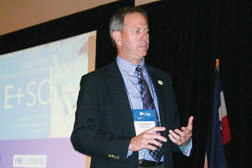Standards and Legislation
Automatic Temperature Adjusting Mechanism Among the Biggest Adjustments
Read More
AHRI Braces for Big Regulatory Year
2014 Annual Meeting Examines Government’s Role in HVACR
Read More
Regional Standards Take Effect; DOE Considers Enforcement
Enforcement Final Rule Expected in Early 2015 for Split-system Central Air Conditioners
Read More
FMI Considers the Future of Supermarket Refrigeration
Research Reveals Optimal Refrigerant Choice is Dependent on Application, Setting
Read More
2014 NEWSmakers Define HVAC’s Future
Honorees Shift the Industry’s Landscape through Litigation, Regulation, and More
December 22, 2014
California Implements Bypass Duct Regulation
Statewide Code Change Regulates Residential Bypass Damper Usage
Read More
EPA Finalizes R-22 Phaseout Timeline
New and Imported R-22 Supplies Set to Decrease Annually Until Production is Prohibited in 2020
Read More
HARDI Leader Balances Government, Growth Initiatives
Talbot Gee Devoted to Regulatory Fairness, Helping Members
Read More
AHRI Launches New Certifications
2 New Programs Will join AHRI's Existing 41 Programs
December 22, 2014
GEO Comments on EPA Rulemaking
Group asks EPA to Recognize Geothermal Heat Pumps in Proposed Rulemaking
December 15, 2014
Copyright ©2024. All Rights Reserved BNP Media.
Design, CMS, Hosting & Web Development :: ePublishing











